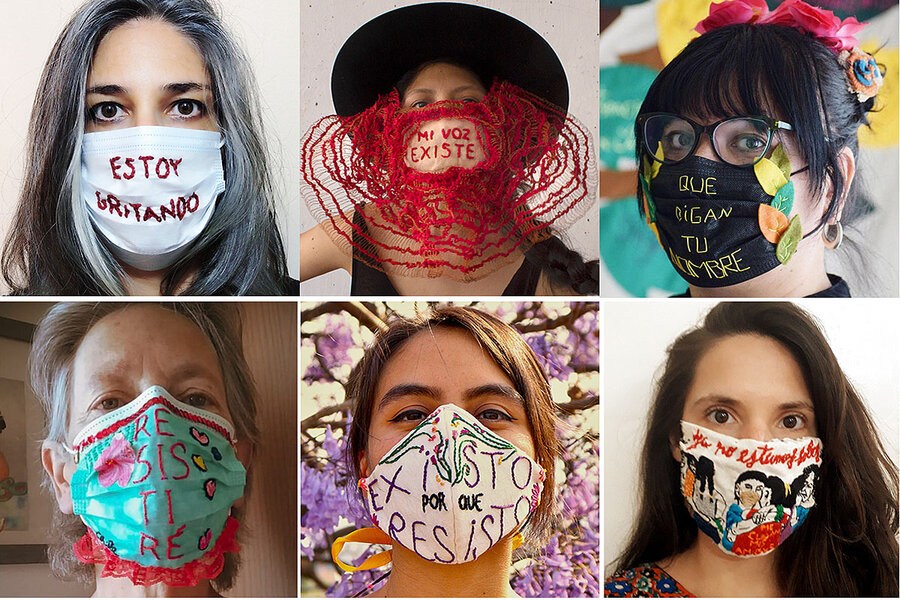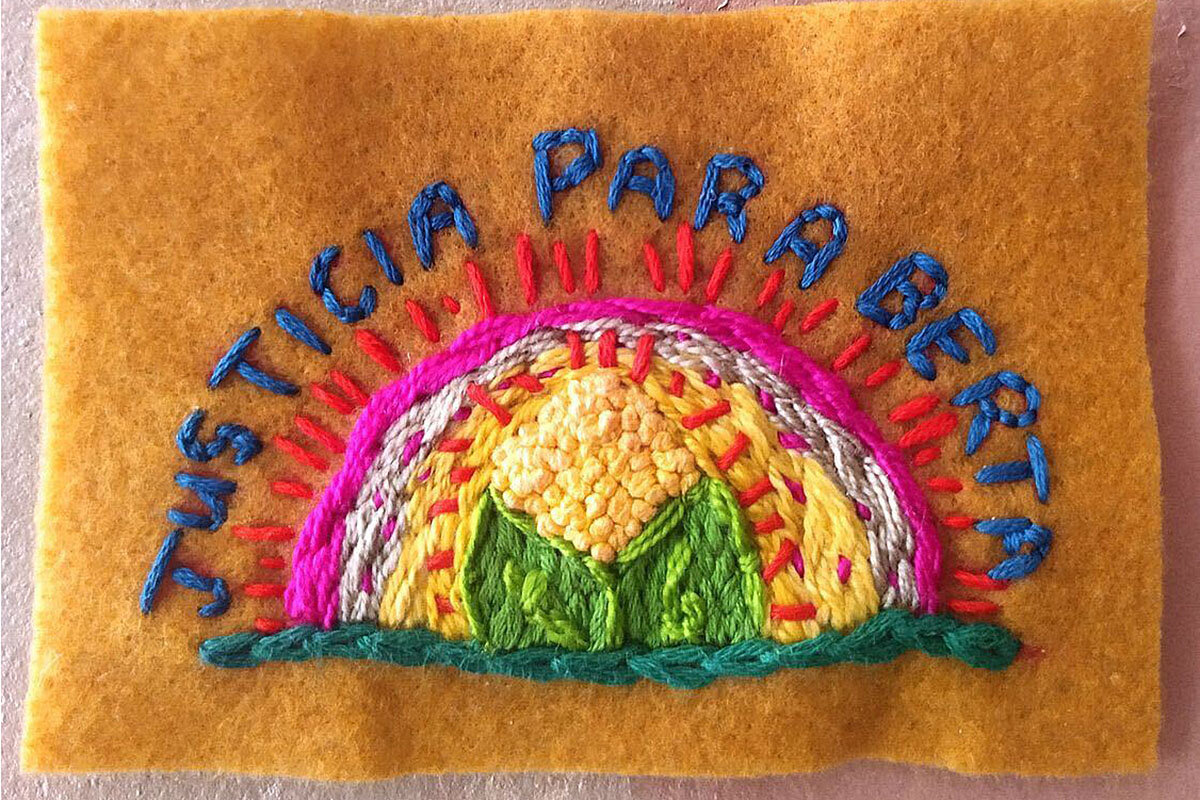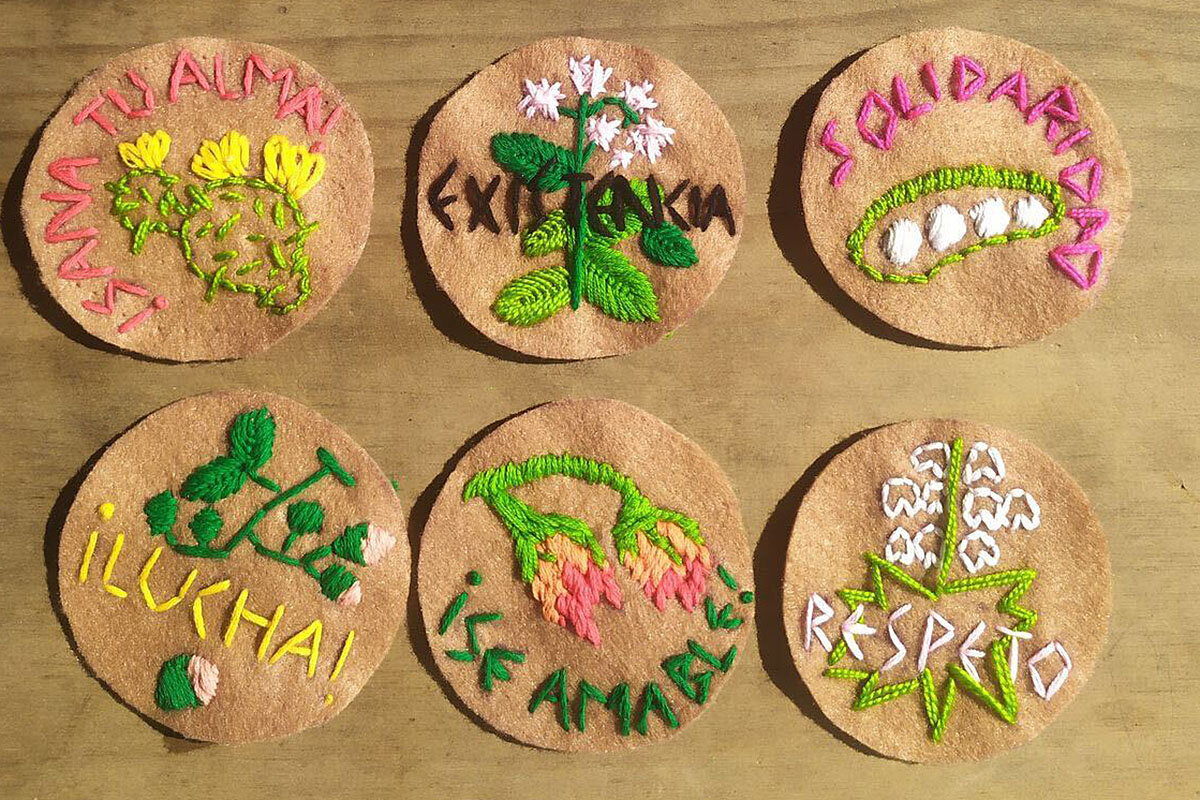Radical stitches: Embroidery gives voice to Latin American activists
Loading...
| Mexico City
Embroidery has a long history in the Americas – a profession once reserved for men, later foisted onto women as a symbol of domesticity. But in recent decades, women have reclaimed the craft as a tool for peaceful, powerful protest, even amid the pandemic.
Just this week, after Mexico City metro cars crashed when an overpass collapsed, embroidery in honor of victims appeared online. Punctuated by orange and green lines, the same colors as the metro, it read, “corruption kills.” Other artists use needlework to call attention to femicide, the ongoing legacy of colonization, or to encourage others to reclaim their history.
Why We Wrote This
These women turn stereotypes about needlecraft upside down. In their hands, beautiful sewing is an act of protest against violence – stitching their pain, resilience, and demands for change.
There’s irony, some artists say, in using something so often associated with meekness to send messages of anger and empowerment.
María Belén Tapia de la Fuente, a Chilean living in Madrid, joined a group of women she met online during the pandemic to talk about the power of embroidery as a political tool.
“When you embroider, you often have to undo earlier stitches,” she explains. “We are undoing the stitches” that society has sewn to create the current world – full of violence and inequality – “and stitching our own stories instead.”
Before the pandemic, Lala Abichain Balberde loved to spend free time embroidering with friends in public squares in her city of Córdoba, Argentina. The craft could be meditative, but the highlight was when strangers approached to see what she was working on.
“[I] always adorn things with colors and flowers and it’s really gorgeous, and people approach and say, ‘How beautiful is this!’” she says. “Then they read the text. And it’s so often just horrible, hideous.”
Ms. Abichain Balberde’s art is an act of protest, raising awareness about Latin America’s high rates of violence and femicides. It isn’t what passersby expect – and that’s exactly why “it opens up a conversation,” she says.
Why We Wrote This
These women turn stereotypes about needlecraft upside down. In their hands, beautiful sewing is an act of protest against violence – stitching their pain, resilience, and demands for change.
Embroidery has a long history in the Americas – a profession once reserved for men, later foisted onto women as a symbol of domesticity. But in recent decades, women have reclaimed the craft as a tool for peaceful, powerful protest, even amid the pandemic.
“Virtual protests” on International Women’s Day on March 8 invited followers to embroider messages “for and by” women, while groups on Instagram stitched masks with words or emotions they often feel muted from expressing, like “fury” or “not quietly, no.” There are online embroidery conventions, where participants embroider the life stories of victims of violence – an act of resistance and memory. Others post embroidered art online about colonization’s ongoing legacy, in hopes of helping others reclaim their culture and history.
There’s irony, some artists say, in using something so often associated with domesticity to send messages full of anger and frustration – and empowerment.
“An innocent practice can convert itself into a weapon that won’t kill anyone but will teach many,” says Ms. Abichain Balberde. She belongs to an Instagram collective called Des-Bordando Feminismos, made up of women stretching from Chile and Argentina to Mexico.
Powerful stitches
“Raquel Padilla Ramos. A woman who loves, believes, and hopes. Victim of femicide on November 7, 2019,” reads a message embroidered in slanting, fuchsia letters on a white handkerchief, made by a member of the Mexican feminist embroidery collective Fuentes Rojas last year.
A black-lettered embroidery punctuated by orange and green lines – the same colors of the Mexico City Line 12 metro cars that crashed after an overpass collapsed May 3 – appeared online the morning after the deadly accident, stating simply, “corruption kills.”
“In the face of government abandonment, popular organizing,” says a small sampler embroidered with a boat and floodwaters. Lara Bohórquez, of the Instagram account Quiriquitana, created the piece in the aftermath of two deadly hurricanes that hit Honduras late last year, amid a sluggish government response.
Since the late 1990s, women in Latin America have increasingly used embroidery to draw attention to acts of violence – against women, migrants, and citizens caught in the crosshairs of drug trafficking or forgotten by elected officials. Often their work is hung clothesline-style in public squares, or near political marches. Other groups have taken to embroidering political messages while riding public transportation, often sparking conversations with other commuters. But their activism has perhaps become even more visible over the course of the pandemic, as life was pushed indoors – and online.
María Belén Tapia de la Fuente, a Chilean living in Madrid, joined a group of women she met online during the pandemic to talk about the power of embroidery as a political tool.
“The intention isn’t to embroider for beauty but for political change,” she says of Des-Bordando Feminismos, made up of roughly 20 women and growing. “What we want to share is the process, the reflection that goes hand in hand with the craft,” she says.
“The decision to use embroidery is significant because it comes from this ‘femininized’ side of things. It’s not traditionally associated with power,” says Alejandra Mayela Flores Enriquez, who teaches art history at the Iberoamericana University in Mexico City and is completing her doctorate thesis on the history of embroidery and feminism.
“On the other hand, you put your body into the act of embroidery, your time, your concentration. It carries pain; sometimes it carries literal blood because you get pricked in the process,” she says.
Ms. Tapia de la Fuente sees other elements of power, too. “When you embroider, you often have to undo earlier stitches,” she explains. “We are undoing the stitches” that society has sewn to create the current world – full of violence and inequality – “and stitching our own stories instead.”
Women’s work?
Embroidery is often associated with women. But for hundreds of years it was considered “men’s work,” says Ms. Flores.
One of the first professional guilds in Mexico established during Spanish colonization was for embroidery, she says. Its central rule? No girls allowed. But that didn’t mean women weren’t creating on their own. Later, the pendulum swung to the opposite extreme, where embroidery became part of what defined a “good” girl. It was central to women’s education, and being a talented embroiderer was linked with being pious, virginal, and a promising mother and wife.
Yet embroidery also gave women a platform, says Ms. Flores, who runs an Instagram account that posts historical examples of embroidery. There’s evidence embroidery was used to make women’s voices heard, long before they were viewed as political actors. When Benito Juárez was president of Mexico in the late 1800s, for example, he took steps to diminish the Roman Catholic Church’s power within government. Many women sent him messages of support – embroidered onto handkerchiefs.
During the so-called Dirty Wars that ravaged Argentina and Chile in the 1970s and ’80s, activism and embroidery became even more overtly linked. The Grandmothers of the Plaza de Mayo in Argentina wore handkerchiefs embroidered with information about their missing children and grandchildren. In Chile, where most voices of protest were silenced by intimidation or death, groups of women created arpilleras – intricately embroidered burlap sacks – depicting the atrocities taking place during Augusto Pinochet’s rule. They were exported around the world.
“They played a really important role because they let people outside of Chile know about the situation,” says Katia Olalde Rico, a professor at the National Autonomous University of Mexico in Morelia who focuses on the intersection of embroidery and protest. “It showed how so many didn’t take textiles seriously, so they weren’t an object of censorship. At least at first.”
“A moment for ourselves”
Ms. Bohórquez, who stitched the hurricane sampler, turned to embroidery at a time of personal crisis. She was studying toward her bachelor’s degree, but “I didn’t feel productive. I didn’t feel like I was serving society,” says Ms. Bohórquez, based in Tegucigalpa, the mountainous capital of Honduras. “So I started embroidering.” She found stitching her thoughts and frustrations therapeutic, touching on themes of capitalism, politics, and violence against women. When the pandemic hit she decided to launch Quiriquitana, where she tells the story of Honduras through embroidery: hurricanes, political corruption, violence, lost traditions, Indigenous history.
“Embroidery can give us tools to think about our lives in a new way. We are putting ourselves out there all the time, but we don’t give ourselves a moment to evaluate how we feel, what we think, what we are doing,” she says. It’s easy to get consumed by frustration and anger over the government, or sexism, she adds, but “embroidery can give us a moment for ourselves.”
Both embroidery and Latin American women “are undervalued, made invisible,” she says. “There’s power in reclaiming that.”










